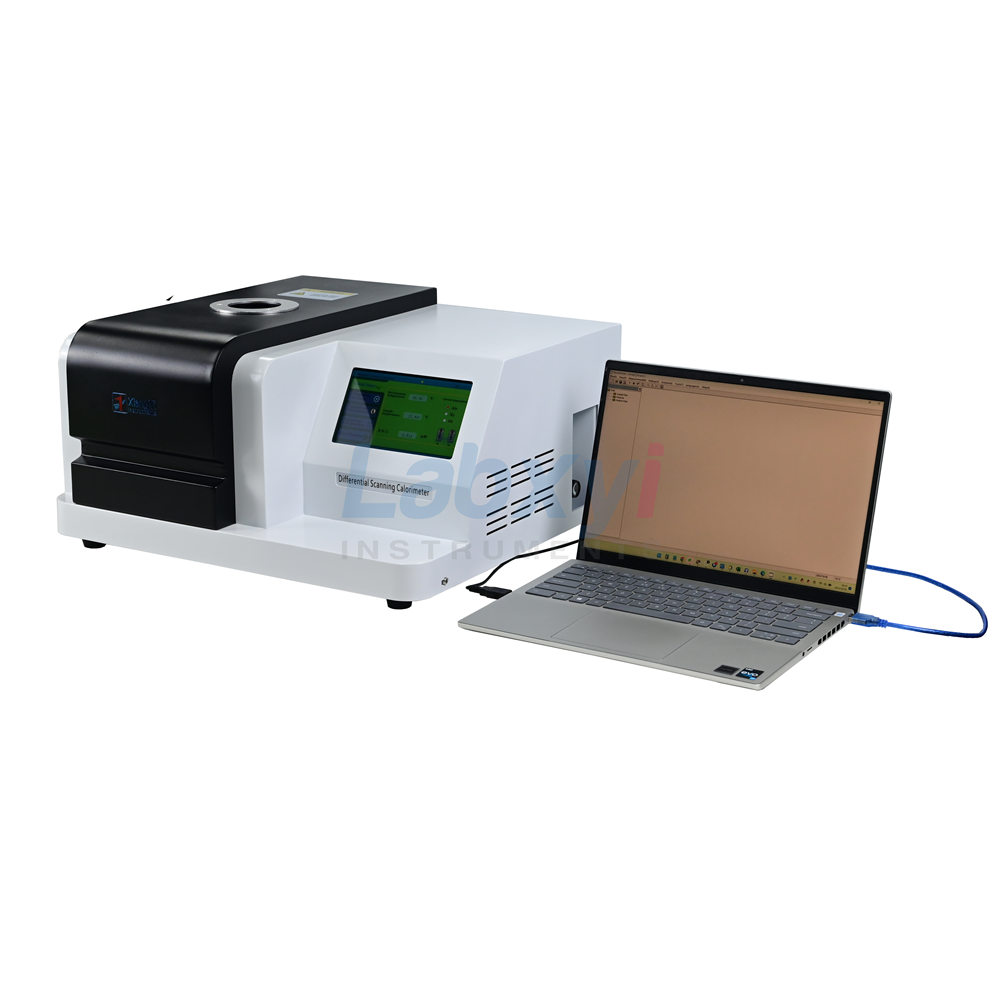Differential Scanning Calorimetry (DSC) analyzes the phase change behavior of a material by measuring the change in heat flow when the material absorbs or releases heat during programmed temperature control. For fiber materials (such as synthetic fibers, natural fibers, or composite fibers), the melting peak temperature is an important parameter to characterize their thermal stability and crystallization properties. The melting peak corresponds to the process in which the ordered structure of the crystalline region in the fiber is destroyed, and the peak temperature can directly reflect the heat resistance and processing suitability of the material.
1.Experimental steps
- Measuring instruments
DSC3000 Differential Scanning Calorimeter

- Sample preparation
2.1 Sampling requirements: Take about 10-20 mg of fiber sample to ensure that the sample is uniform and free of contamination.
2.2 Preprocessing
If the fibers are in the form of filaments or bundles, they need to be cut into powder or short fiber segments to avoid uneven heat conduction.
If it is necessary to eliminate the thermal history (such as residual stress during processing), a heating and cooling cycle treatment can be performed first (such as heating to 200°C at 10°C/min and then cooling).
- Instrument calibration
3.1 Use standard substances (such as indium and tin) to calibrate the temperature and heat flow signals of the DSC.
3.2 Ensure nitrogen or inert gas protection (flow rate 50-100 mL/min) to avoid interference with the oxidation reaction.
- Test parameter settings
4.1 Temperature range: Set the temperature range according to the fiber type (e.g. 30°C to 300°C).
4.2 Heating rate: usually 10~20°C/min (10°C/min is usually used). Too high a heating rate will cause peak temperature deviation and needs to be adjusted in accordance with literature or standard methods.
4.3 Repeated testing: Conduct at least 2 to 3 parallel experiments for each group of samples to verify data repeatability.
- Experimental operation
5.1 Spread the sample evenly in an aluminum crucible.
5.2 Set up a blank crucible as a reference and place it into the DSC furnace at the same time as the sample crucible.
5.3 Start the temperature rise program and record the heat flow curve in real time.
2.Data Analysis
- Melting peak identification
The DSC curve was analyzed by software to locate the endothermic peak (melting peak).
3.Common Problems and Solutions
- Baseline drift or high noise
Cause: Too much sample, the crucible is not sealed tightly or the gas flow rate is unstable.
Solution: Reduce the sample amount to less than 5 mg, check the crucible tightness, and calibrate the gas flow rate.
- Melting peak splitting or multi-peak phenomenon
Cause: The sample contains impurities or is not completely dried (interference from water evaporation).
An uneven crystal structure is formed during processing.
Solution:
2.1 Improve the resolution by adjusting the heating rate (e.g., reducing it to 5°C/min).
2.2 Anneal the sample (keep it at a specific temperature and then cool it down) to eliminate metastable crystals.
2.3 Dry the fiber thoroughly before testing (place it in a dryer or vacuum oven).
- The test results deviate greatly from the literature values
Cause: fiber batch differences, additives (such as flame retardants, plasticizers) or blending modification effects.
The calibration is inaccurate or the instrument status is abnormal.
Solution:
3.1 Compare the literature data of samples from the same source to confirm the consistency of material composition.
3.2 Recalibrate the instrument and check the sensor sensitivity and the sealing of the furnace.
- Sample thermal decomposition interferes with the melting peak
Cause: Certain fibers (such as natural fibers or synthetic fibers containing heat-sensitive groups) degrade before melting.
Solution:
4.1 Use inert gas (such as nitrogen) protection to reduce the risk of oxidative degradation.
4.2 Use rapid heating (e.g. 20°C/min) to shorten the high temperature residence time.
4.Experimental Notes
- Sample representativeness: Fiber samples must be taken from the same batch to avoid data deviation due to production process fluctuations.
- Avoid contamination: Use tweezers to take and place samples and crucibles to prevent contamination from hand grease.
- Data comparability: The melting peak temperatures at different heating rates cannot be directly compared, and the test conditions must be specified.
- Instrument maintenance: Clean the DSC furnace regularly to avoid residues affecting heat conduction.
5.Application Examples
5.1 Case: Melting behavior analysis of recycled polyester fibers
Background: Due to the complex processing history of recycled PET fibers, the melting peak may appear broadened or shifted.
5.2 Measurement parameter settings
Heating rate: 10°C/min, nitrogen protection (50 mL/min).
Temperature range: 30~300°C.
5.3 Results Analysis
The melting peak temperature is about 3~5°C lower than that of virgin PET, indicating that the crystal integrity is impaired.
The 30% reduction in melting enthalpy verifies the decrease in crystallinity during the recycling process.
6.Experimental Conclusion
Differential scanning calorimetry provides an efficient and sensitive means for characterizing fiber melting behavior. By standardizing the sample preparation process, optimizing test parameters and rationally analyzing data, key thermodynamic parameters such as melting peak temperature can be accurately obtained, providing theoretical support for the design, processing and recycling of fiber materials.
